|
|
|
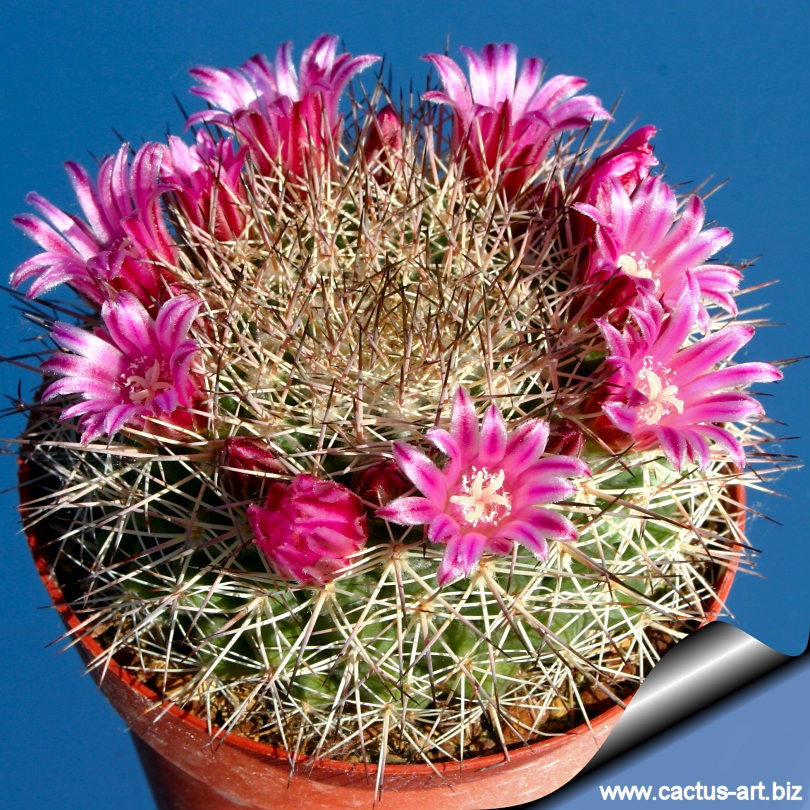
Mammillaria grusonii SB1725 Viesca, Coahuila, Mexico
|
|
Description: It is
undoubtedly one of the
largest species in the
genus and usually solitary (it has a tendency to
remain the same in the culture).
It reveals its true beauty only as it
becomes 6 -10
years old, and reaches
30 cm or more in diameter.
Stems: globose to thick cylindrical, light blue-green, up to 30
cm and 25 cm in diameter.
Tubercule: Basally
four-angled , carinate, without latex,
Axil: Woolly at first, later naked.
Radial spine: 12 - 14, straight, needle-like,
upper ones shorter, 6 - 8
mm long, at first reddish, tipped brown,
later grey or snowy-
white.
Central spine: Usually 2 (or rarely 3), straight, stronger than
the radial, one ascending, one descending, 4 - 6 mm long.
Flower: Bell shaped, funnel-form,
diurnal,
light yellow-cream or pinkish with darker (brown or purple) midstripe
with a yellowish throat, up to 25 mm long and in diameter.
Blooming season (Europe): Spring, and flowers remain
open for about three or four days.
Fruit: Scarlet, club shaped
Seed: Brown.
|
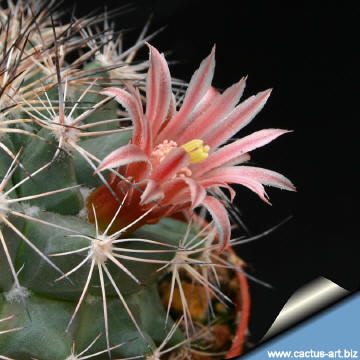 |
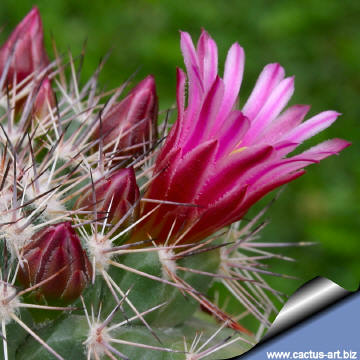 |
|
. |
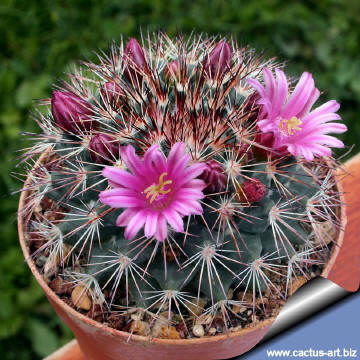 |
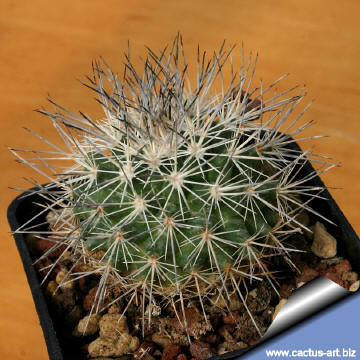 |
|
. |
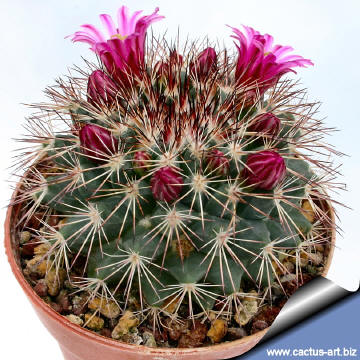 |
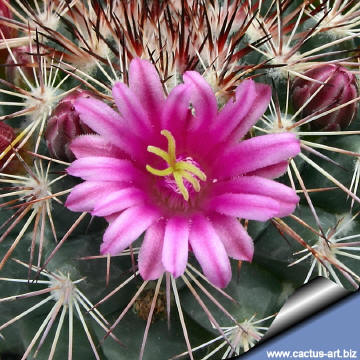 |
|


Advertising
|
|
|
|
|
|
|
Family:
Cactaceae (Cactus
Family)
Scientific name: Mammillaria
grusonii
First description:
by Runge,
Gartenflora 38: 105 with fig. (1889)
Origin: Mexico,
COAHUILA (Sierra Bola, Cerro Bola, Viesca, Puerto de Ventanillas,
San Pedro de las Colonias, Cuatrocienegas, Cerro Zavaleta, El Carmen, San
Rafael, Pinaje de Leone, Pomona/Paile, La Pena, Tacubaya, Torreon -
Cuencame, San Antonio, El Amparo, La Cuchilla), and DURANGO
(Penon Blanco, Nazas - Rodeo, Belem, La Concha, Cuencame, San Bartolo,
Cerro Visnaga, Lerdo, Santiago Papasquiaro)
Habitat: Grows
on the top and slope of hills, or in flat areas at about 800 - 1.850 m of
altitude
Conservation status: Listed in
CITES appendix 2.
Synonyms:
-
Mammillaria mexicensis R.T.Craig
-
Mammillaria pachycylindrica Backeb.
-
Mammillaria zeyeriana K.Schum
-
Mammillaria durangicola
-
Mammillaria papasquiarensis
-
Mammillaria tesopacensis var. papasquiarensis
|
|
|
|
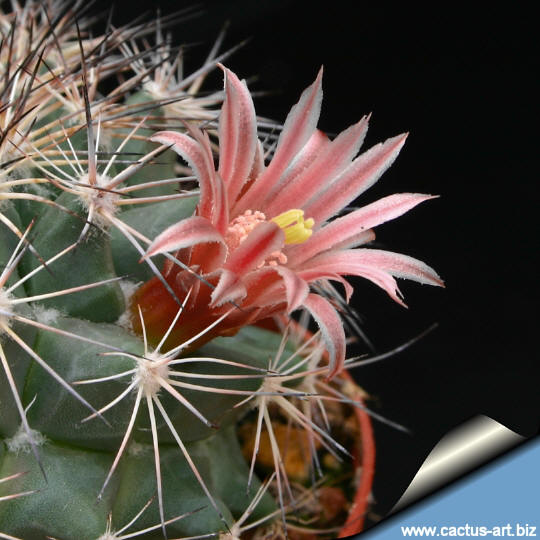
|
|
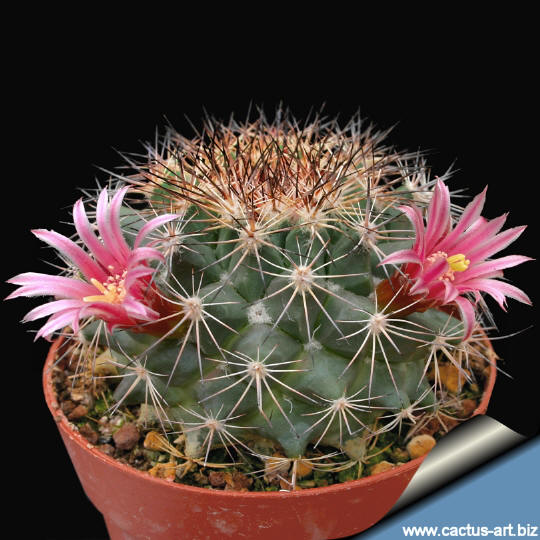 NOTE: There are a number of
varieties and
segregate species of
this variable cactus species, but not all are universally
recognized. Some
authorities recognize the following:
Mammillaria pachycylindrica (Reppennhagen considered it a separate
form) with more spines, 20–23 grayish-white radials and about 6 centrals,
at first dark, blackish-brown, becoming gray, tepals lobes with a wide
brownish-pink midstrip.
Mammillaria durangicola This form has 10-16 radials, 4-15 mm
long, 1 - 3 central, 10-17mm long, black, and flowers as in Mammillaria
pachycylindrica, with
a brownish midstrip.
Mammillaria papasquiarensis is a longer form, with 8-10 radial
spines, 5-40 mm long, and 1 to 3 central spines, 40 - 100 mm long.
The
flowers are white with
a pinkish midstrip.
Mammillaria zeyeriana
:
The spines are of intermediate
measurement, of which the radials are 10 to 15, 8-15 mm long, and the
centrals usually 4 (but sometime up to 6), 12 - 25 mm long.
The flowers
are similar to the last mentioned.
Mammillaria mexicensis has dark
pink flowers.
Cultivation: This plant
blooms easily and needs lots of light. Use a pot
with good drainage and a very porous
mineral-based potting mix. Potted
plants are quite
wet-sensitive, especially in light of its small root system.
Water sparingly during the
growing season, let soil dry in between to prevent root rot,
keep very dry in
winter. Feed
with a high potassium fertilizer in summer.
Usually it is recommended to
over-winter
this plant in a bright and warm greenhouse with at least 8-10° C , but
it has proven
to be quite
frost resistant
(if kept dry it is
hardy as low as -7° C). A resting period
in winter and strong light are necessary so that it can flower properly.
Plants will offset readily,
and dense clumps can be produced in a very few years.
Propagation: Through seeds and
cuttings.
|
|
Photo of conspecific
taxa, varieties, forms and cultivars of Mammillaria grusonii
|
|